 W
WSlovenian cuisine is influenced by the diversity of Slovenia's landscape, climate, history and neighbouring cultures. In 2016, the leading Slovenian ethnologists divided the country into 24 gastronomic regions. The first Slovene-language cookbook was published by Valentin Vodnik in 1798.
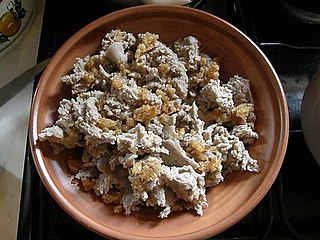 W
WAjdovi žganci is a sort of žganci. Translated to English, it would be termed "buckwheat mush" or "buckwheat spoonbread". It is a national Slovene dish. Balthasar Hacquet (1739–1815) mentions that žganci was served with sauerkraut in Upper Carniola. The oldest preparation method explains the word žganci. The word žganci is derived from the Slovenian verb žgati meaning "to burn" or "to toast". Ajdovi žganci are served together with obaras, meat sauces, sauerkraut, Black pudding, various sausages. The ingredients may vary through different regions.
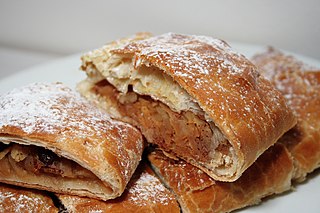 W
WApple strudel is a traditional Viennese strudel, a popular pastry in Austria, Bavaria, Czech Republic, Northern Italy and in many other countries in Europe that once belonged to the Austro-Hungarian Empire (1867–1918).
 W
WBuchteln, are sweet rolls made of yeast dough, filled with Powidl, jam, ground poppy seeds or quark, and baked in a large pan so that they stick together. The traditional Buchtel is filled with plum Powidl jam. Buchteln are topped with vanilla sauce, powdered sugar or eaten plain and warm. Buchteln are served mostly as a dessert but can also be used as a main dish. In the 19th century they could be boiled similar to dumplings.
 W
WĆevapi, ćevapčići is a grilled dish of minced meat found traditionally in the countries of southeast Europe. It is considered a national dish of Bosnia and Herzegovina, and is also common in Serbia, Croatia, Montenegro, Kosovo, North Macedonia and Slovenia.
 W
WChrain is a spicy paste made of grated horseradish. It is a common condiment for meat and fish dishes in Eastern and Central European cuisines. Chrain comes from Yiddish כריין, which is in turn a loanword from Slavic languages.
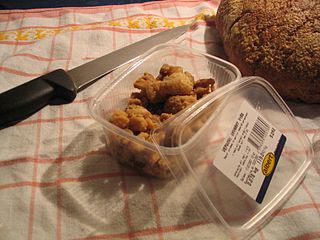 W
WČvarci is a specialty popular in Southeastern Europe, a variant of pork rinds. They are a kind of pork cracklings, with fat thermally extracted from the lard.
 W
WFritaja (Croatian) or frtalja is a Mediterranean Croatian and Slovenian dish. Both are specialties in Istria and north from Trieste in Goriška Brda and in Soča valley. They are especially common in the springtime, as at that time there are many plants and vegetables such as wild asparagus, wild hops, herbs as fennel, mint, feverfew and chicory, tomatoes, young garlic sprouts and spices available to add to egg and some other ingredients, as small parts of old bread. Fritaje are many times prepared throughout the year with ham, mushrooms, sausages, bacon, white or red wine. The quantity of ingredients is never exactly defined.
 W
WGnocchi are a varied family of dumpling in Italian cuisine. They are made of small lumps of dough composed of semolina, ordinary wheat flour, egg, cheese, potato, breadcrumbs, cornmeal or similar ingredients, and possibly including herbs, vegetables, and other ingredients. The dough for gnocchi is most often rolled out before it is cut into small pieces about the size of a wine cork. The dumplings may be pressed with a fork or a cheese grater to make ridges or cut into little lumps. Gnocchi are usually eaten as a first course, but they can also be served as a contorno to some main courses.
 W
WGoulash is a soup or stew of meat and vegetables seasoned with paprika and other spices. Originating in Hungary, goulash is a common meal predominantly eaten in Central Europe but also in other parts of Europe. It is one of the national dishes of Hungary and a symbol of the country.
 W
WIdrijski žlikrofi are traditional Slovenian dumplings that originate from Idrija. They are made from dough with potato filling and are often served either as a side dish to meat or on their own, in which case they are topped with breadcrumbs. The recipe dates back to the mid 19th century and remains one of the most popular Slovenian dishes. Žlikrofi were awarded an EU protected geographical status in 2010 as Traditional Speciality Guaranteed, the first Slovenian dish to do so.
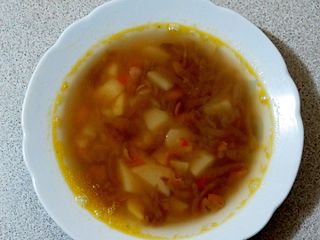 W
WThe Istrian stew or jota is a stew, made of beans, sauerkraut or sour turnip, potatoes, bacon, spare ribs, known in the northern Adriatic region. It is especially popular in Istria and some other parts of northwestern Croatia. Under the name jota, it is also typical of the whole Slovenian Littoral and in the former Austro-Hungarian territories in northeastern Italy, especially in the provinces of Trieste and Gorizia, and in some peripheral areas of northeastern Friuli. The stew, based on etymology, most likely originated in Friuli before spreading east and south. "Jota" seems to derive from a Celtic root and has parallels in the ancient friulano language and in modern emilian-romagnol.
 W
WKnedle, is a dish of boiled potato-dough dumplings filled with plums or apricots, originating from the Austro-Hungarian Empire. Popular in Central and East European countries, the dish is eaten as dessert, a main dish, or side dish.
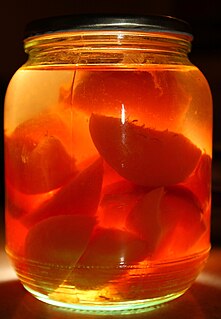 W
WKompot or compote is a non-alcoholic sweet beverage that may be served hot or cold, depending on tradition and season. It is obtained by cooking fruit such as strawberries, apricots, peaches, apples, raspberries, rhubarb, plums, or sour cherries in a large volume of water, often together with sugar or raisins as additional sweeteners. Sometimes different spices such as vanilla or cinnamon are added for additional flavour, especially in winter when kompot is usually served hot. Kompot is popular in Central and Eastern European countries as well as in Southern Europe.
 W
WThe Carniolan sausage is a Slovenian sausage most similar to what is known as kielbasa or Polish sausage in North America.
 W
WKrofne are airy filled doughnuts. They are round and usually filled with jelly, marmalade, jam or chocolate as well as butter, nutella and cinnamon. They can also be filled with custard, or cream, but that is usually less common. The name comes from German Krapfen, and it is a variation of the Central European pastry known as the Berliner. They are also similar to beignets.
 W
WLicitars are colorfully decorated biscuits made of sweet honey dough that are part of Croatia and Slovenia's cultural heritage. They are a traditional symbol of the Croatian capital Zagreb. They are used as an ornamental gift, often given at celebrations of love such as weddings and St, Valentine's Day. At Christmas time, the city of Zagreb and the Christmas tree in the main square in particular are festooned with thousands of licitar hearts.
 W
WMatevž is a Slovene national dish. The dish is typical of central Slovenia, especially of the Kočevsko region. It is made of beans and potatoes. Its origins come from the 19th century. Originally the lower social classes ate it as a main course. The dish is also known as krompirjev mož, medved (bear) or even as belokranjski mož. The term matevž is a derivative from male name Matej or Matevž (Matthew). Matej or Matevž word origins to many other dialectical expressions: to have matevža means to have a hangover.
 W
WMerienda is a light meal in southern Europe, particularly Spain, Portugal (merenda), Catalan speaking places (berenar), Aragonese speaking places and Italy (merenda), as well as Hispanic America, the Philippines, North Africa (Morocco) and Brazil. Usually taken in the afternoon or for brunch, it fills in the meal gap between the noontime meal and the evening meal, being the equivalent of afternoon tea in the English-speaking world; or between breakfast and lunch. It is a simple meal that often consists of a piece of fruit, cookies, yogurt, and other snacks paired with juice, milk, hot chocolate, coffee, spirits, or other beverages.
 W
WA mille-feuille, vanilla slice or custard slice, similar to but slightly different from the Napoleon, is a pastry whose exact origin is unknown. Its modern form was influenced by improvements made by Marie-Antoine Carême.
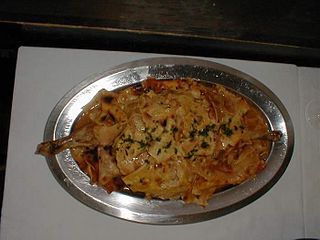 W
WMlinci is a dish in Croatian, and Slovenian cuisine. It is a thin dried flatbread that is easy to prepare by simply pouring boiled salted water or soup over the mlinci.
 W
WA nut roll is a pastry consisting of a sweet yeast dough that is rolled out very thin, spread with a nut paste made from ground nuts and a sweetener like honey, then rolled up into a log shape. This 'log' is either left long and straight or is often bent into a horseshoe shape, egg washed, baked, and then sliced crosswise. Nut rolls resemble a jelly roll but usually with more layers of dough and filling, and resemble strudels but with fewer and less delicate dough layers. Fillings commonly have as their main ingredient ground walnuts or poppy seeds.
 W
WPierogi are filled dumplings made by wrapping unleavened dough around a savoury or sweet filling and cooking in boiling water. They are often pan-fried before serving.
 W
WPig slaughter is the work of slaughtering domestic pigs which is both a common economic activity as well as a traditional feast in some European and Asian countries.
 W
WPogača is a type of bread baked in the ashes of the fireplace, and later on in the oven, similar to focaccia. found in the cuisines of the Balkans, and Turkey. It can be leavened or unleavened, but only experienced cooks can make good-quality unleavened pogača, while the pastry with yeast is easier to make. It is generally made from wheat flour, but barley and sometimes rye may be added. It can be stuffed with potatoes, ground beef, or cheese, and have grains and herbs like sesame, black nigella seed, or dried dill in the dough or sprinkled on top.
 W
WPolenta is a dish of boiled cornmeal that was historically made from other grains. It may be served as a hot porridge, or it may be allowed to cool and solidify into a loaf that can be baked, fried, or grilled.
 W
WProsciutto, in full prosciutto crudo, is Italian uncooked, unsmoked, and dry-cured ham. Prosciutto crudo is usually served thinly sliced.
 W
WPunjena paprika is a Balkan dish made of peppers, stuffed with a mix of meat and rice in tomato sauce, the ingredients consisting of green or red capsicums, eggs, spices, salt, tomato, minced meat and rice. It is particularly popular in Southeast Europe.
 W
WRičet is a traditional Slovenian, Croatian, Austrian and Bavarian dish. It is a thick soup. It contains pot barley, beans, potatoes, carrots, parsley, celery, leeks, tomatoes, onions, and garlic. There is typically a substantial amount of cured pork in it. In essence it is a starchy dish, similar to a risotto. By adding more water it can be easily turned into a heavy soup dish.
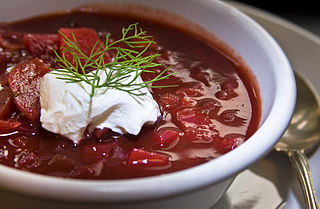 W
WSmetana is a type of sour cream from Central and Eastern Europe. It is a dairy product produced by souring heavy cream. It is similar to crème fraîche, but nowadays mainly sold with 9% to 42% milkfat content depending on the country. Its cooking properties are different from crème fraîche and the lighter sour creams sold in the US, which contain 12 to 16% butterfat. It is widely used in cooking and baking.
 W
WŠtruklji are a traditional Slovene dish, composed of dough and various types of filling. The dish comes in the form of rolls, which can be either cooked or baked, and can have a wide range of fillings. Štruklji has been traditionally reserved for special occasions, but is now one of the most characteristic everyday dishes in households all across Slovenia. It is closely related to Zagorski Štrukli, a traditional Croatian dish.
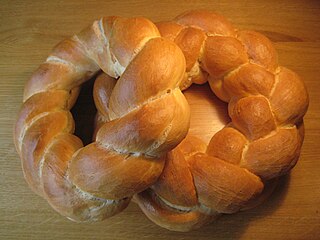 W
WVrtanek is a type of bread associated with Prekmurje, Slovenia. According to Protestant church reports dating to 1627 it was local custom for members of parish to give vrtanek as a gift for christenings and weddings. It was a typical feast food made for celebrations of the harvest. The same braided, round loaf is recorded as torta panis in 1698. In modern times it's a festive loaf appropriate for many types of celebrations, public events and large receptions.
 W
WŽganci is a dish in Slovenian and Croatian cuisine, known as Sterz in Austria, pura on the Croatian coast, and also known in northern Italy. It is a traditional "poor man's food" of hard-working farmhands similar to polenta, although prepared with finer grains.